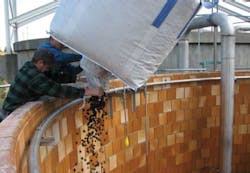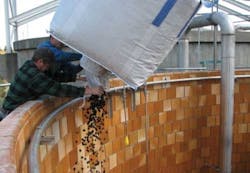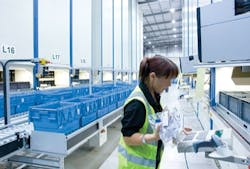New System Automates Microbiological Detection
Assessing the microbiological quality of drinking water is a routine test performed by every drinking water operator in the world as specified by the relevant national drinking water regulators. Advances in water microbiology are now taking a new direction towards automation with focus not on the specific method of detection, as all the current methods are well proven, but on the fundamental process of sample collection, preparation and interpretation of results to ensure faster detection of positive samples.
One new method, the Tecta™ B16 Automated Microbiological Detection System, not only provides faster results to a positive E. coli or total coliform but also challenges the traditional framework of microbiology testing within a laboratory. Developed and marketed by Endetec™, the global sensor platform of Veolia Water Solutions & Technologies, the system features built-in incubation, UV light emission, a sophisticated optical system and a special sample test cartridge for the detection of E. coli and total coliforms.
The technology uses a combined enzyme substrate method for detecting the expression of the two enzymes ß-D-glucuronidase and ß-D-galactosidase which hydrolyze the substrate and create hydrophobic fluorescent markers, at two different light wavelengths. These markers need a non-aqueous environment which is provided by a polymer nub at the base of the special sample cartridge
The Tecta CCA test cartridge is manufactured and pre-sterilized with all the necessary reagents to simultaneously perform both E. coli and total coliform tests to eliminate the sample preparation performed in the laboratory. The base of the cartridge is injected with a siloxane-based polymer which adsorbs the fluorescent hydrophobic markers isolating them from the solution. The fluorescence is then detected in the polymer through an optical fiber rather than in the sample itself.
By continuously shining ultra-violet light onto the polymer and using a spectrophotometer to interrogate the light at the two fluorescent wavelengths the instrument can determine the presence of contamination as soon as it is detected above a base threshold level and inform the user much earlier than methods that use fixed-time incubation.
The process of extracting the fluorescent markers from the solution removes the problems caused by turbidity and water color in traditional subjective tests. Also, high contaminated samples (containing 109 colonies) require no dilution before testing thus eliminating a dilution step.
The "time to detection" for a positive result is related to the initial concentration of target bacteria in the sample and linked to enzyme expression kinetics. In cases where a sample is heavily contaminated, symptomatic of a drinking water sample contaminated by fecal matter, a positive result can be recorded in less than 3 hours. Low contamination (between 1 and 10 cfu/100ml) will be detected in around 15 hours.
In order to confirm a negative result the instrument continuously incubates the sample and interrogates the optical detection process for a period of 18 hours after which the absence of coliforms and E.coli can be confirmed. As each different strain of coliform will express enzyme at different rates, and enzyme expression is also impacted by the bacteria's condition (i.e. stressed or non-stressed) the "time to detection" cannot be used to accurately determine the quantitative level of contamination but does provide a degree of severity of contamination which the water operator can use to determine the responsive action required to protect their consumers.
To support this new test method the Tecta B16 system has been designed to provide more tools to assist in reporting early warning of positive contamination. One key feature is a remote reporting function as part of the system hardware. Every test result creates an electronic record which can be displayed on the instrument's HMI and transmitted to a known IP address via Ethernet. An SMS or email with the test result can be sent directly to a smart phone or computer ensuring that a positive / negative result is known by the operator rapidly – a useful function when the result is positive and requires immediate action.
The development of automated microbiology where result interpretation is no longer by a human being, raises several questions on how and where it can be deployed to best serve the challenges of today's water operators. As sample preparation, dilution and result interpretation is no longer needed, routine microbiology testing is now available in non-laboratory environments and to non-microbiologists. The time from sampling to result is no longer governed by sample transportation, laboratory working hours and availability of resources. Faster results are possible in the situations when they are most needed – mains water breaks, customer complaints and during changes in water treatment plant operation and maintenance.
More WaterWorld Current Issue Articles
More WaterWorld Archives Issue Articles


